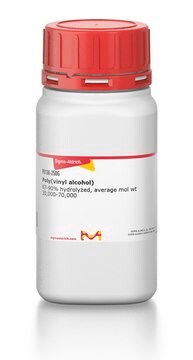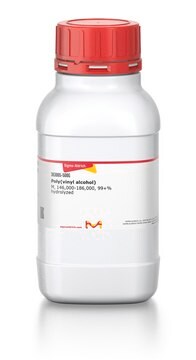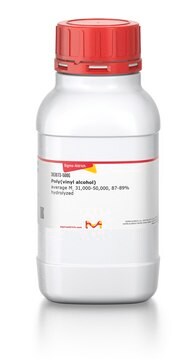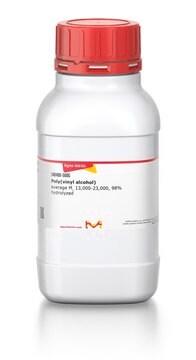363170
Alcool polyvinylique
Mw 13,000-23,000, 87-89% hydrolyzed
Synonyme(s) :
PVA
About This Item
Produits recommandés
Niveau de qualité
Forme
crystalline powder
crystals or granules
powder
Poids mol.
Mw 13,000-23,000
Chute de bille
3.5-4.5 cP, 4 % in H2O(20 °C)(lit.)
InChI
1S/C2H4O/c1-2-3/h2-3H,1H2
Clé InChI
IMROMDMJAWUWLK-UHFFFAOYSA-N
Vous recherchez des produits similaires ? Visite Guide de comparaison des produits
Description générale
Application
It can be used to prepare a hydrogel template to produce homogeneous microparticles for sustained drug release. PVA is used as a stabilizer in micro-particle preparation due to its high tensile strength and flexibility.
Caractéristiques et avantages
- Good mechanical and chemical stability
- Non-toxic
- Tunable hydrophilicity
- Resistance to solvents Capable of forming films
Code de la classe de stockage
11 - Combustible Solids
Classe de danger pour l'eau (WGK)
WGK 1
Point d'éclair (°F)
No data available
Point d'éclair (°C)
No data available
Équipement de protection individuelle
Eyeshields, Gloves, type N95 (US)
Faites votre choix parmi les versions les plus récentes :
Déjà en possession de ce produit ?
Retrouvez la documentation relative aux produits que vous avez récemment achetés dans la Bibliothèque de documents.
Les clients ont également consulté
Notre équipe de scientifiques dispose d'une expérience dans tous les secteurs de la recherche, notamment en sciences de la vie, science des matériaux, synthèse chimique, chromatographie, analyse et dans de nombreux autres domaines..
Contacter notre Service technique











